If you're new here, you may want to subscribe to my RSS feed. Thanks for visiting!
Do you want to learn MORE about herbalism from Cat Ellis?
Check out her Herbal Skills Intensive course!!!
Sometimes things happen very, very quickly and require attention just as quickly, preferably before they become serious. Some of the snowstorms we’ve been experiencing of late have overwhelmed hospitals and put a stop to emergency services. If the ambulance can’t get to you because the plow hasn’t cleared your street, small injuries can become big issues quickly. Cuts, scrapes, animal and spider bites, infections, and abscesses can all become problems if left untreated.
In this article, I’ll discuss some herbal treatments along with any available scientific bases. The references I’m using are Cat Ellis’s Prepper’s Natural Medicine, The Green Pharmacy by James Duke, and Brigitte Mars’ Natural First Aid Handbook. (All of these books are OP-recommended!)
But first, to keep the FDA happy, the Disclaimer: We no doctors here! We no give medical advice! Reader do own research and make own choices! If you’re in distress you go nearest ER!
The following herbal remedies appear in all three references, so those are the ones I’ll cover. This list is by no means exhaustive. Reference books are our friends! Those I’ve listed include recipes for powders, tinctures, and other formulations, along with specific information on each herb’s uses.
Arnica

Ellis notes that this herb is contraindicated in pregnancy and should not be ingested, and Mt Sinai agrees with this. Indications are for a traumatic injury that doesn’t break the skin, such as bruises, sprains, and pulled things. Both Ellis and Duke note its efficacy as an antiseptic. It shouldn’t be used long-term.
Mt Sinai notes that one study found increased pain when used long-term for leg ulcers. This PubMed article notes that arnica was as good or better on various points when compared to diclofenac following foot surgery.
As I noted in a previous article, the black belts in my dojo kept arnica gel for pain relief. I found that a good basis for recommendation.
Calendula

Ellis recommends this for use in throat and oral ailments, as well as diaper rash.
Duke gives a recipe for treating cuts and also notes that the flower rubbed on bee and wasp stings can ease the pain and bring down the swelling. Mars notes the infection-fighting properties of this herb as well on page 42.
A systemic review on PubMed yields mixed results and states the need for further clinical studies.
The Biomedical and Pharmacology Journal conducted a study on rats that showed clear evidence of calendula’s wound-healing properties.
Calendula is easy to grow and won’t look out of place or garner attention as anything other than a pretty flower in your home garden. In warm climates, it’s a short-lived perennial and in colder climates, it should be treated as an annual.
Comfrey
Ellis lists this as a wound-healing wonder, though she notes that the pyrrolizidine alkaloids can become a problem if comfrey is ingested for too long. Duke notes that comfrey is very effective for this application, while Mars notes that a poultice applied to the site will relieve the pain and swelling for bruises.
Healthline gives several precautions, most notably with respect to ingesting comfrey, and notes that it’s contraindicated in pregnancy and breastfeeding.
I’ve used it as a salve for back pain but have always been careful not to use it too much or on open wounds due to the potential for alkaloid poisoning. Used carefully, it’s a good choice for both pain and wound healing.
Echinacea
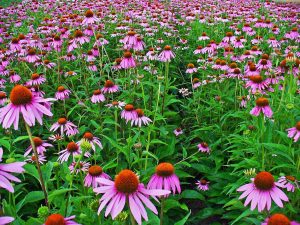
Mars notes this as effective in healing scorpion stings, provided that immediate medical attention isn’t required. Ellis also recommends it used as a tincture on venomous bites. She recommends its use in wound powders due to its antibacterial and pain-numbing properties. Mars notes the infection-fighting properties of this herb as well on page 42.
Medical News Today discusses echinacea for use in colds and bronchial infections and gives mixed reviews on its many anecdotal uses here. Ellis also mentions that using this herb for respiratory ailments is a waste, pointing out that while echinacea supports the immune system it’s not an immune tonic.
Duke recommends its use to strengthen the immune system and treat superficial wounds, adding that the numb tongue one gets when drinking echinacea is harmless. URMC lists a number of contraindications here.
Also known as purple coneflower, this healing herb would look pretty in your flowerbed.
Honey
Duke in Green Pharmacy notes that while honey isn’t exactly an herb, it has been used for centuries as a kind of natural bandage. Ellis extolls the virtues of honey for its production of small amounts of hydrogen peroxide when in contact with moist, wounded tissues. She also notes that several herbs can be infused into honey, including yarrow, St. John’s wort, echinacea, and sphilanthes.
A PubMed systematic review again yields mixed evidence and states the need for further clinical study. Another PubMed study discusses its use here. Our friend Laurie Neverman of Common Sense Homesteading has written a wonderful article on the healing properties of honey here.
Plantain
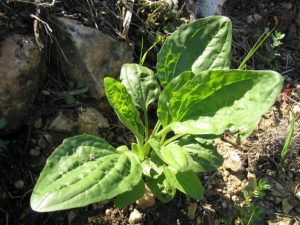
Ellis discusses plantain as being ideal for burns, cuts, bites, and scrapes on pages 105-106. She suggests cleaning the burn with clear water to stop the spread first and foremost, then applying plantain as a poultice. Duke gives its uses for burns, insect bites and stings, poison ivy, sore throat, and sunburn, among other things.
This Healthline article supports its uses in wound healing and other applications, also noting it as an edible weed.
Ellis made me laugh when reading about her neighbor’s view of her lawn, which contains both plantain and dandelion in copious quantities. Evidently, her neighbors don’t like it any better than mine do, but too bad! I also like free food and refuse to spray to get rid of it. My city demands that things it considers noxious weeds, including plantain and yarrow, be cut regularly. Fine, no problem! My medicine cabinet thanks you.
St John’s wort
Mars suggests a few drops of this on spider bites, both venomous and simply itchy. Duke isn’t crazy about this herb for this purpose but says he’d use it in a pinch. Ellis recommends its use in wound care infused into honey. She mentions that its use as an antidepressant is important, but its wound care properties are really more important since this herb heals from the inside-out, which is how wounds are best healed.
My vet mentioned this progression of healing several years ago while treating my cat Pinker, the terror of the neighborhood. Pinker never met a fight he didn’t like, with one exception (a car, which he also lived through), and the vet taught me how to deal with the wounds since I was in college-induced poverty then. He discussed healing wounds from the inside out so that infectious material wasn’t trapped in the wound, and Ellis seems to hold this view as well.
This PubMed article supports its use in wound healing.
Lavender oil
Mars notes this as effective in healing scorpion stings, as an insect repellent, and for bruises. She notes the infection-fighting properties of this herb as well on page 42. Ellis recommends lavender for ear infections, and Duke lists uses in burns and pain management.
PubMed lists a systemic review of studies showing positive effects in wound healing, though this review does suggest that further trials and standardization of formulation is required to recommend lavender essential oil for this purpose.
Tea tree oil
Mars lists tea tree oil as an insect repellent. She suggests a few drops in a diffuser or in water as a spray to discourage insects in the area. Duke lists tea tree oil as effective in wound healing as well as the treatment of fungal infections and a number of other ailments.
Healthline gives a number of possible uses for this herb, including wound healing here. They also suggest a patch test first to determine if you’re allergic.
Yarrow
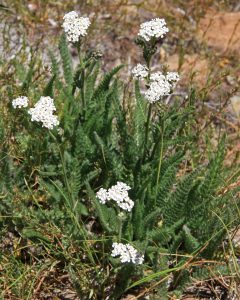
This one is a personal favorite. It grows in my yard and would take over the universe if I let it! My city considers it a noxious weed and demands I keep it cut, and given my experience with yarrow in stopping the bleeding, I’m happy to comply!
Ellis does give contraindications for its use in pregnancy and breastfeeding, however. Duke suggests yarrow for treating amenorrhea and menstrual cramps, while Mars gives it, among other things, as a treatment for bleeding.
Healthline suggests efficacy in wound healing and other ailments as a tea. This PubMed-listed study shows efficacy in wound healing as well.
I use mine as either a poultice applied directly to the wound or a tincture.
Yarrow is generally pretty easy to acquire in most parts of North America. It can be found in cities, suburbs, rural areas, and the boondocks. While it prefers open, sunny places, it also grows in partial shade in the forest.
Be careful if it’s growing by a busy roadside or highway, as it could be contaminated with fumes and pollution. You may want to harvest your yarrow from a different location.
So there we have it!
Again, this list is far from exhaustive but does show a scientific basis for the use of herbal medicines in wound treatment. With supply chain shortages, weather conditions, and other problems overwhelming hospitals, and multitudinous other problems it makes sense to add herbal therapies to your medical preps. If you want to learn more about herbal medicine, making herbal remedies, and becoming comfortable with using herbs to support health, we strongly recommend taking Cat Ellis’s Herbal Skills Intensive course over on SelfRelianceandSurvival.com.
Do you use these or other common herbs to treat wounds? Which ones are your favorite? Do you have an herbal book you want to add to our list of recommendations?
Please tell us in the comments section!
Check Put Our Herbal Skills Intensive Course!!!
About Amy Allen
Amy Allen is a professional bookworm and student of Life, the Universe, and Everything. She’s also a Master Gardener with a BS in biology, and has been growing food on her small urban lot since 2010.

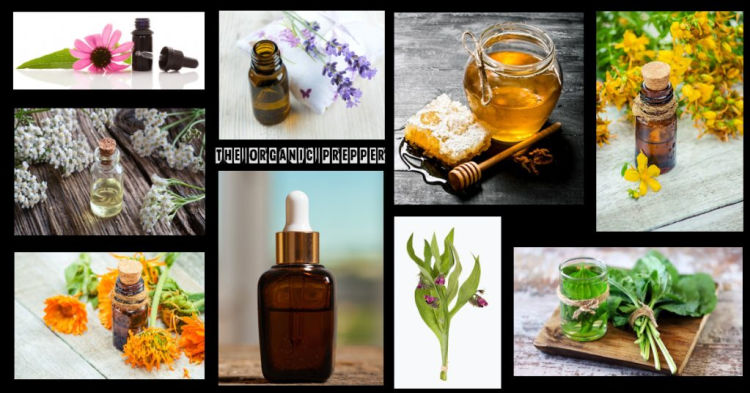
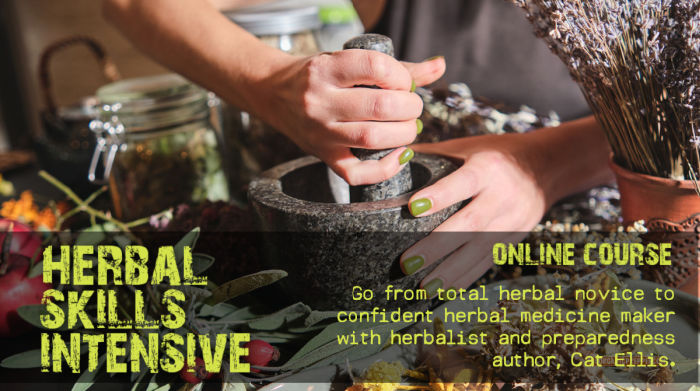














6 Responses
I do use some of these herbs, as well as others, for tinctures and salves. Cayenne is one that I keep on hand, sage, stinging nettle, mullien and others. I use “Practical Herbalism” by Fritchey, “Backyard Pharmacy” by Rachel Weaver and “Herbal Antibiotics” by Buhner as my go-to books.
Thanks for those resources! I’ll check them out!
You forgot an easy astringent … oak bark . boiled and cooled.
And baking soda on a bee sting … but on wasp stings use something acidic like lemon /lime juice or vinegar . The venoms chemistry are opposites.
And hardwood charcol is really good to have in case of poisoning or just upset stomach .
Then there are willows , natural aspirin.
Cloves… good topical analgesic (pain relief) .
Oregano , anti bacterial/antiviral.
Thyme , antibacterial /anti viral.
Alliums (aka onions /garlic) they contain allicin , an antibiotic.
These are easy within reach remedies.
As I mentioned in the article: the list is far from exhaustive. Thanks for these other mentions! I’m sure we’ll all find them quite helpful.
Maori in NZ used chewed up kavakava (NZ spelling kawakawa) leaves on wounds.
When I was stung by a scorpion (the little, more deadly kind) I immediately went online to see if I had something on hand to remedy the excruciating pain and avoid more serious effects. Several remedies were recommended on a variety of credible web sites, and I tried a half-dozen. The stand-out remedy which worked wonders was frankincense essential oil. I keep it on hand for various health benefits, so I tried it last (because it worked so much better than the other remedies). Almost immediate relief from the intense pain; reduction of swelling and redness at the sting site over just a few minutes; and zero illness or other harms from the sting. The Magi knew what they were doing when they gifted gold, frankincense and myrrh to infant Jesus.